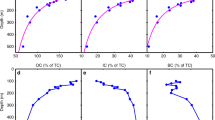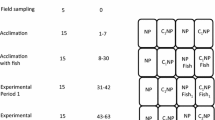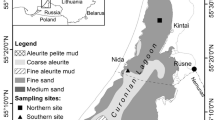Abstract
A compartmental model of energy flux through a continental shelf ecosystem is presented which examines the potential for significant energy flow through detritus microorganisms, and dissolved material to terminal consumers. A number of assumptions are examined which have bearing on the outcome of the modeling exercise. Evidence is reviewed that primary production may be substantially higher than the usual 14C method indicates. If this were the case there would be great latitude possible for the other assumptions inherent in the models but for the present it is assumed that current estimates of photosynthesis in the sea are approximately correct. Evidence is presented that the input of primary detritus (new plant material) is a significant one, although relatively little of it is present in samples of particulate matter. Secondary detritus, principally fecal material, takes many forms and is involved in both benthic and pelagic food webs. The observations that bacteria mediate the utilization of detritus by metazoans, but that there are very few bacteria on detritus particles, are not necessarily in contradiction. However, little is known about the rate of growth of bacteria on particles and the frequency with which particles pass through the guts of detritivores. Similar information is also lacking about the population of free-living bacteria in the water.
Since there is little agreement about the significance of energy flux through detritus, dissolved material, and microorganisms, a model was constructed so that all, one, or none of them could move a major fraction of the energy fixed by primary; production. If the steps in such a model are assumed to be trophic levels, and the ecological efficiency of transfer of energy is assumed to be 10% per trophic level, such an anastomosing model will not carry enough energy to the terminal consumers. If we accept the proposition that the compartments in such a model do not fit the concept of trophic levels, and if we use existing data on gross growth efficiencies to estimate the efficiency of transfer of energy between the compartments, any of the several pathways can be a major energy conduit. However, large changes in energy flux from one pathway to another result in changes in the amount of energy available to various terminal consumer groups. The results indicate that either conventional assumptions about ecological assimilation efficiency are low by a factor of 2–3, or current measurements of photosynthesis are low by a factor of 5–10. While this modeling exercise in no way proves that alternative energy pathways are important in real continental shelf ecosystems, it shows that there is no underlying reason why they may not be. Situations in the real world are described which may result in shifts of energy flux from direct consumption of phytoplankton by grazers to consumption of microorganisms which are growing on detritus and dissolved materials.
Access this chapter
Tax calculation will be finalised at checkout
Purchases are for personal use only
Preview
Unable to display preview. Download preview PDF.
Similar content being viewed by others
References
Aldredge, A. L., 1976. Discarded appendicularian houses as sources of food, surface habitats, and particulate organic matter in planktonic environments, Limnol. Oceanogr. 21: 14–23.
Andrews, P. and P. J. LeB. Williams, 1971. Heterotrophic utilization of dissolved organic compounds in the sea. III. Measurement of the oxidation rates and concentrations of glucose and amino acids in sea water, J. Mar. Biol. Ass. U. K. 51: 111–125.
Azam, F. and R. E. Hodson, 1977. Size distribution and activity of marine microheterotrophs, Limnnol. Oceanogr. 22: 492–501.
Banse, K., 1962. Net zooplankton and total zooplankton, Rapp. Proc.-Verb. Réunions, Cons. Perm. Int. Explor. Mer 153: 211–214.
Beers, J. R. and G. L. Stewart, 1967. Micro-zooplankton in the euphotic zone at five localities across the California current, J. Fish. Res. Bd Can. 24: 2053–2068.
Beers, J. R. and G. L. Stewart, 1970. Numerical abundance and estimated biomass of microzooplankton, Bull. Scripps. Inst. Oceanogr. 17: 67–87.
Beers, J. R. and G. L. Stewart, 1971. Micro-zooplankters in the plankton communities of the upper waters of the eastern tropical Pacific, Deep-Sea Res. 18: 861–883.
Clarke, G. L., 1946. Dynamics of production in a marine area, Ecol. Mongr. 16: 323–335.
Conover, R. J., 1962. Metabolism and growth in Calanus hyperboreus in relation to its life cycle, Rapp. Proc.-Verb. Réunions, Cons. Perm. Int. Explor. Mer. 153: 190–196.
Corner, E. D. S. and C. B. Cowey, 1968. Biochemical studies on the production of marine zooplankton, Biol. Rev. 43: 393–426.
Cushing, D. H., 1959. On the nature of production in the sea, Fishery Invest. II, 22: 1–41, H. M. Stationery Office, London.
Derenbach, J. B. and P. J. LeB. Williams, 1974. Autotrophic and bacterial production: fractionation of plankton populations by differential filtration of samples from the English Channel, Mar. Biol. 25: 263–269.
Edwards, R. R. C., D. M. Finlayson, and J. H. Steele, 1969. The ecology of O-group plaice and common dabs in Loch Ewe. II. Experimental studies, J. Exp. Mar. Biol. Ecol. 3: 1–17.
Ferguson, R. L. and R. Rublee, 1976. Contribution of bacteria to standing crop of coastal plankton, Limnol. Ooeanogr. 22: 141–145.
Finenko, Z. Z., 1978. Production in plant populations, In: Marine Ecology 43 edited by O. Kinne, 13–87, John Wiley & Sons, New York.
Gordon, D. C., 1970a. A microscopic study of non-living organic particles in the North Atlantic Ocean, Deep-Sea Res. 17: 175–185.
Gordon, D. C., 1970b. Some studies on the distribution and composition of particulate organic carbon in the North Atlantic Ocean, Deep-Sea Res. 17: 233–243.
Gulland, J. A., 1970. Food chain studies and some problems in world fisheries, In: Marine Food Chains, edited by J. H. Steele, 296–315, University of California Press, Berkeley.
Hempel, G., 1970. Introduction, In: Marine Food Chains, edited by J. H. Steele, 255–260, University of California Press, Berkeley.
Ho, K. P. and W. J. Payne, 1970. Assimilation efficiency and energy contents of prototrophic bacteria, Biotechnol. Bioengineering, in press.
Ivleva, I. V., 1970. The influence of temperature on the transformation of matter in marine invertebrates, In: Marine Food Chains, edited by J. H. Steele, 96–112, University of California Press, Berkeley.
Joiris, C., 1977. On the role of heterotrophic bacteria in marine ecosystems: Some problems, Helgo. wiss. Meeresunters. 30: 611–621.
King, J. D. and D. C. White, 1977. Muramic acid as a measure of microbial biomass in estuarine and marine samples, Appl. Env. Microbiol. 33: 777–783.
Koblentz-Mishke, O. J., V. V. Volkovinsky, and J. G. Kabanova, 1970. Planktonic primary production of the World Ocean, In: Scientific Exploration of the South Pacific, 183–193, Nat. Acad. Sci. U. S., Washington.
Lasker, R., 1970. Utilization of zooplankton energy by a Pacific sardine population in the California current, In: Marine Food Chains, edited by J. H. Steele, 265–284, University of California Press, Berkeley.
Lasker, R., 1973. Field criteria for survival of anchovy larvae: the relation between inshore chlorophyll maximum layers and successful first feeding, Fishery Bull. 73: 453–462.
Lenz, J., 1972. The size distribution of particles in marine detritus, Mem. 1st. Ital. Idrobiol. 29 Suppl.: 17–35.
Lindeman, R. L., 1942. The trophic-dynamic aspect of ecology, Ecology 23: 399–418.
McAllister, C. D., 1969. Aspects of estimating zooplankton production from phytoplankton production, J. Fish. Res. Bd Can. 26: 199–220.
McLaren, I. A., 1963. Effects of temperature on growth of zooplankton, and the adaptive value of vertical migration, J. Fish. Res. Bd Can. 20: 685–727.
Marshall, S. M. and A. P. Orr, 1962. Food and feeding of copepods, Rapp. Proc.-Verb. Réunions, Cons. Perm. Int. Explor. Mer 153: 92–98.
Miller, R. J., K. H. Mann, and D. J. Scarratt, 1971. Production potential of a seaweed-lobster community in Eastern Canada, J. Fish. Res. Bd Can. 28: 1733–1738.
Mullin, M. M. and E. R. Brooks, 1970. Growth and metabolism of two planktonic, marine copepods as influenced by temperature and type of food, In: Marine Food Chains, edited by J. H. Steele, 74–95, University of California Press, Berkeley.
Odum, E. P. and A. de la Cruz, 1967. Particulate organic detritus in a Georgia salt marsh-estuarine ecosystem. In: Estuaries, edited by G. H. Lauff, 383–388, AAAS Publ. 83. Washington, D. C.
Odum, H. T., 1967. IBP Symposium: environmental photosynthesis, Science 157: 415–416.
Paffenhöfer, G.-A., 1975. On the biology of Appendicularia of the southeastern North Sea, Proc. 10th European Symposium on Marine Biology 2: 437–455.
Payne, W. J., 1970. Energy yields and growth of heterotrophs, Ann. Rev. Microbiology 24: 17–52.
Petipa, T. A., E. V. Pavlova, and G. N. Mironov, 1790. The food web structure, utilization and transport of energy by trophic levels in the planktonic communities, In: Marine Food Chains, edited by J. H. Steele, 142–167, University of California Press, Berkeley.
Pomeroy, L. R., 1974. The ocean’s food web, a changing paradigm, Bioscience 24: 499–504.
Pomeroy, L. R., H. H. Haskin, and R. A. Ragotzkie, 1956. Observations on dinoflagellate blooms, Limnol. Oceanogr. 1: 54–60.
Pomeroy, L. R. and R. E. Johannes, 1966. Total plankton respiration, Deep-Sea Res. 13: 971–973.
Pomeroy, L. R. and R. E. Johannes, 1968. Occurrence and respiration of ultraplankton in the upper 500 meters of the ocean, Deep-Sea. Res. 15: 381–391.
Porter, K. G., 1977. The plant-animal interface in freshwater ecosystems, Amer. Sci. 65: 159–170.
Rao, K. P., 1953. Rate of water propulsion in Mytilus califomianus as a function of latitude, Biol. Bull. 104: 171–181.
Reeve, M. R., 1970. The biology of Chaetognatha. I. Quantitative aspects of growth and egg production in Sagitta hispida, In: Marine Food Chains, edited by J. H. Steele, 168–189, University of California Press, Berkeley.
Riley, G. A., 1970. Particulate organic matter in sea water, Adv. Mar. Biol. 8: 1–118.
Riley, G. A., 1972. Patterns of production in marine ecosystems, In: Ecosystem Structure and Function. Oregon State University Annual Biology Colloquium 31, edited by J. A. Wiens, 91–100, Oregon State University Press, Corvallis.
Riley, G. A., H. Stommel, and D. F. Bumpus, 1949. Quantitative ecology of the plankton of the Western North Atlantic, Bull. Bingham Oceanogr. Coll. 12: 1–169.
Roman, M. R., 1978. Ingestion of the blue-green alga Trichodesmium by the harpactacoid copepod, Macrostella gracilis, Limnol. Oceanogr. 23: 1245–1248.
Ryther, J. H., 1969. Photosynthesis and fish production in the sea, Science 166: 72–76.
Sheldon, R. W. and W. H. Sutcliffe, Jr., 1978. Generation times of 3 h for Sargasso Sea microplankton determined by ATP analysis, Limnol. Oceanogr. 23: 1051–1055.
Sieburth, J. McN., 1976. Bacterial substrates and productivity in marine ecosystems, Ann. Rev. Ecol. System. 7: 259–285.
Sieburth, J. McN., 1977. Convener’s report on the informal session on biomass and productivity of microorganisms in planktonic ecosystems, Helgo. wiss. Meeresunters. 30: 697–704.
Sieburth, J. McN., K. M. Johnson, C. M. Burney, and D. M. Lavoie, 1977. Estimation of in situ rates of heterotrophy using diurnal changes in dissolved organic matter and growth rates of picoplankton in diffusion cultures, Helgo. wiss. Meeresunters. 30: 565–574.
Slobodkin, L. B., 1960. Ecological energy relationships at the population level, Amer. Nat. 94: 213–236.
Slobodkin, L. B., 1961. Growth and Regulation of Animal Populations, 184 pp., Holt, Rinehart, and Winston, New York.
Slobodkin, L. B., 1970. Summary. In: Marine Food Chains, edited by J. H. Steele, 537–540, University of California Press, Berkeley.
Sorokin, Yu., 1978. Decomposition of organic matter and nutrient regression. In: Marine Ecology 4, edited by O. Kinne, 501–616, John Wiley & Sons, New York.
Steele, J. H., 1965. Some problems in the study of marine resources, Spec. Pubs. Int. Comm. N. W. Atlantic Fisheries No. 63 463–476.
Steele, J. H., 1974. The Structure of Marine Ecosystems, 128 pp., Harvard University Press, Cambridge, Mass.
Thomas, J. P., 1971. Release of dissolved organic matter from natural populations of marine phytoplankton, Mar. Biol. 11: 311–323.
Wangersky, P. J., 1977. The role of particulate matter in the productivity of surface waters, Helgo. wiss. Meeresunters. 30: 546–564.
Watson, S. W., T. J. Novitsky, Helen L., Quinby, and F. W. Valois, 1977. Determination of bacterial number and biomass in the marine environment, Appl. Env. Microbiol. 33: 940–946.
Wiebe, W. J. and L. R. Pomeroy, 1972. Microorganisms and their association with aggregates and detritus in the sea: a microscopic study, Mem. 1st. Ital. Idrobiol. 29 Suppl.: 325–352.
Wiegert, R. G., R. R. Christian, J. L. Gallagher, J. R. Hall, R. D. H. Jones, and R. L. Wetzel, 1975. A preliminary ecosystem model of a coastal Georgia Spartina marsh, In: Estuarine Research Vol. 1, edited by L. E. Cronin, 583–601, Academic Press, New York.
Wiegert, R. G. and D. F. Owen, 1971. Trophic structure, available resources, and population density in terrestrial vs. aquatic ecosystems, J. Theor. Biol. 30: 69–81.
Williams, P. M., H. Oeschger, and P. Kinney, 1969. Natural radiocarbon activity of the dissolved organic carbon in the north-east Pacific Ocean, Nature 224: 256–258.
Author information
Authors and Affiliations
Editor information
Editors and Affiliations
Rights and permissions
Copyright information
© 1979 Plenum Press, New York
About this chapter
Cite this chapter
Pomeroy, L.R. (1979). Secondary Production Mechanisms of Continental Shelf Communities. In: Livingston, R.J. (eds) Ecological Processes in Coastal and Marine Systems. Marine Science, vol 10. Springer, Boston, MA. https://doi.org/10.1007/978-1-4615-9146-7_9
Download citation
DOI: https://doi.org/10.1007/978-1-4615-9146-7_9
Publisher Name: Springer, Boston, MA
Print ISBN: 978-1-4615-9148-1
Online ISBN: 978-1-4615-9146-7
eBook Packages: Springer Book Archive




